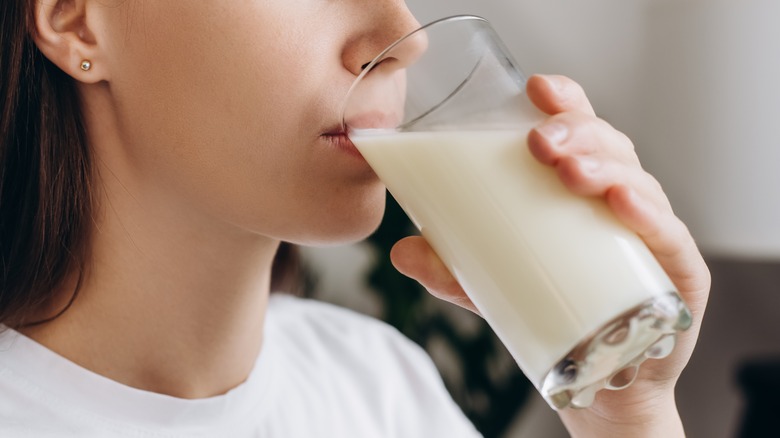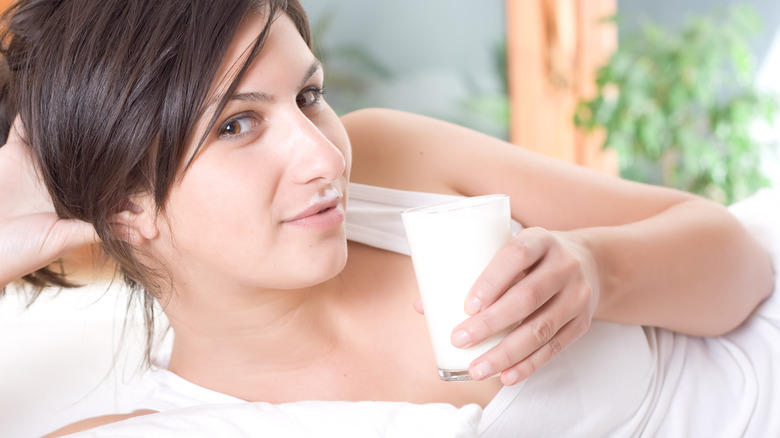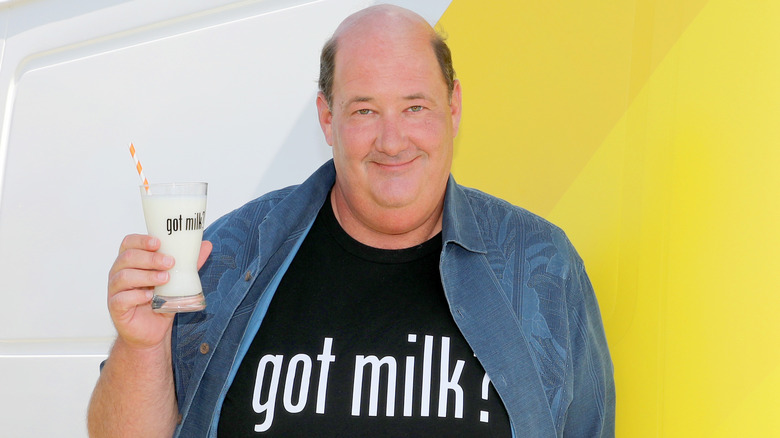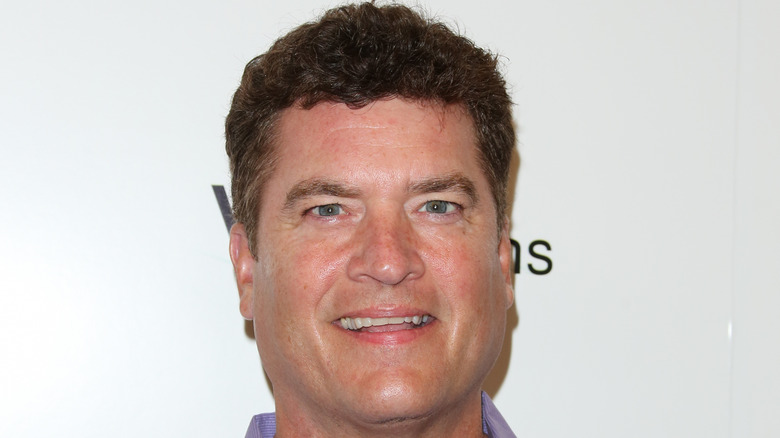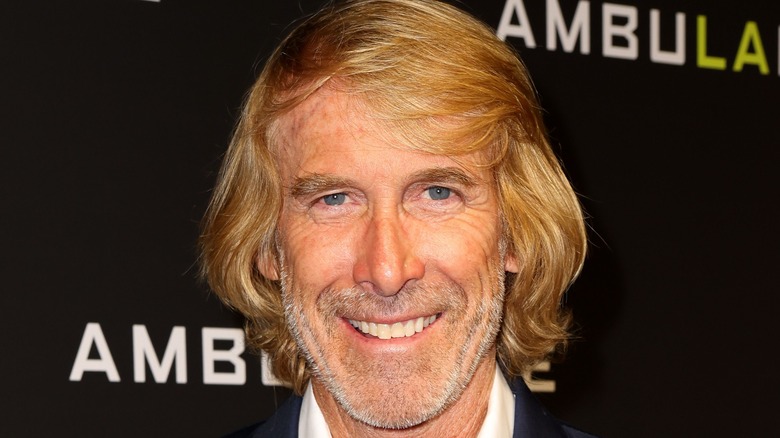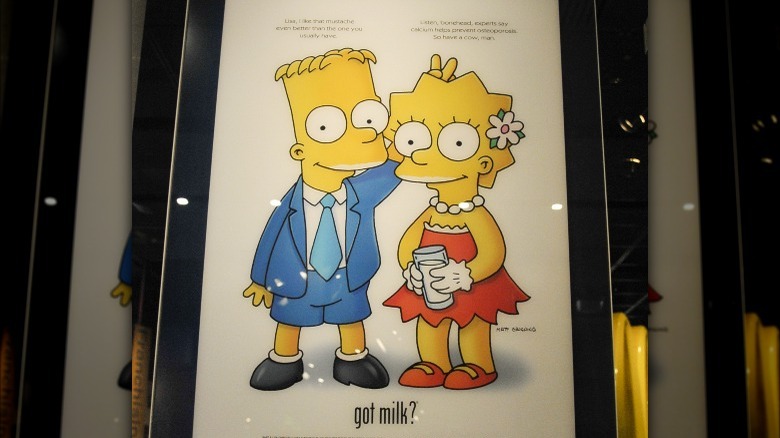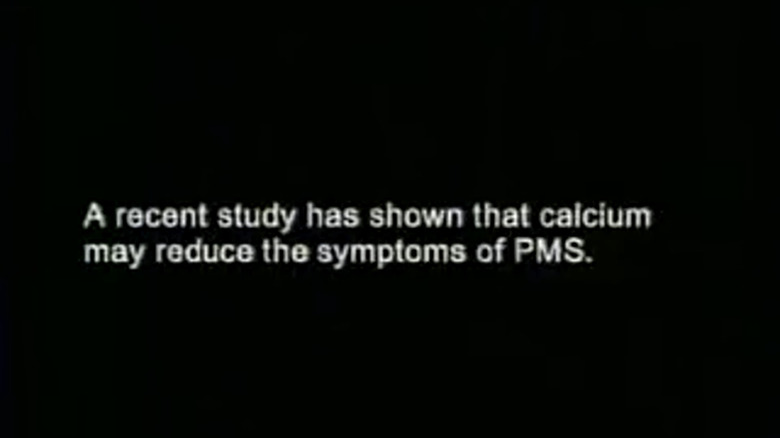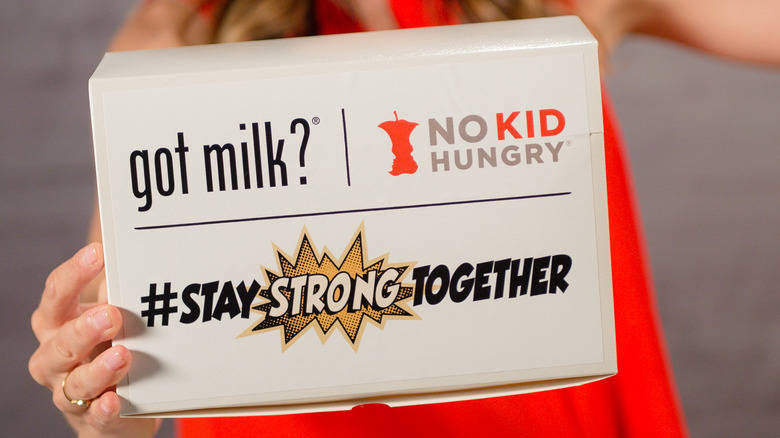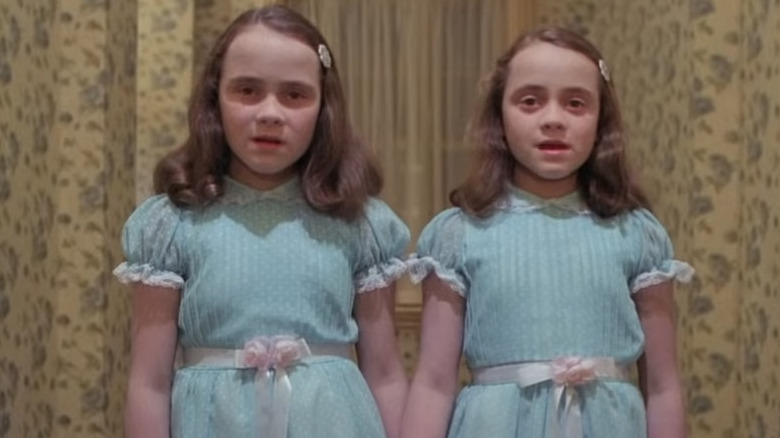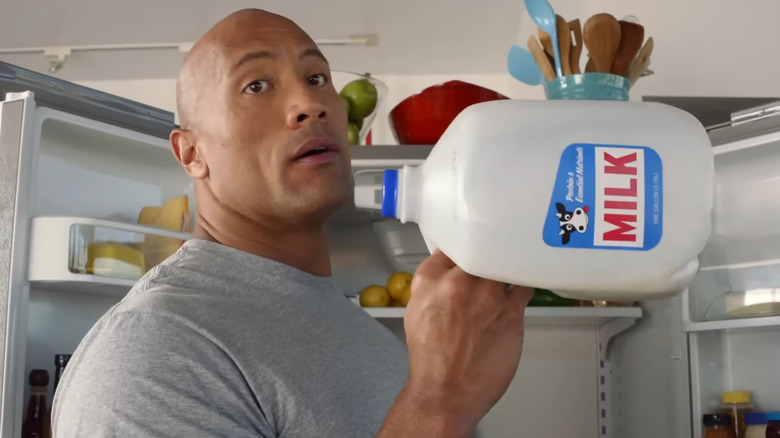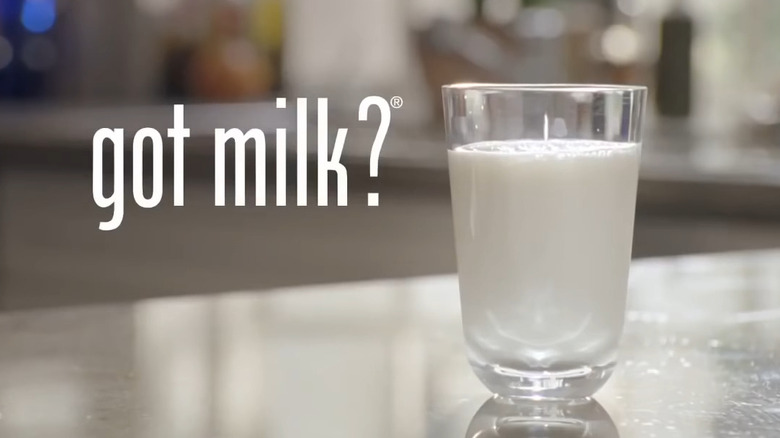Things Only Adults Notice About Those Got Milk Ads
Milk does a body good ... as long as you drink the proper type. Of course, the plethora of milk varieties available in 2023 – including dairy, plant-based versions, and Aubrey Plaza's "Wood Milk" – makes choosing the right beverage a perilous task. If only we could turn back the clock to the 1990s and 2000s, when the ubiquitous series of Got Milk ads made the decision for us. After all, who could resist the dairy-derived drink after seeing the Hanson brothers adorned with milk mustaches?
If we were keeping score between decades, the Got Milk advertisements would be big wins for the '90s and '00s. Displayed in television commercials, magazines, and through countless other avenues, they were often startlingly simple, featuring celebrities staring ahead sultrily with a prominent milk mustache. But the commercials could range into the truly absurd territory at times, too — because what's more ludicrous than a group of elderly birthday-goers preparing to pummel a magician?
Now, while Got Milk ads aren't a thing of the past, revisiting some of the classic campaigns (and viewing them from a more mature perspective) reveals some fascinating insights — the type only grown-ups might recognize. With that in mind, here are things only adults notice about those Got Milk ads.
The print advertisements were often bizarrely sexual for a dairy-based ad campaign
Sex sells — at least, that tends to be the prevailing theory in marketing, regardless of whether a product is inherently sexual in any real way. If executives believe they can incentivize consumers to break the bank by pushing those boundaries, anything goes to make a buck. In that sense, the sexually-charged nature of many Got Milk print ads (an aspect of the advertisements only glaringly apparent to adults) is actually less confusing than it may have appeared at first blush.
To be clear, not every Got Milk print ad was designed to stimulate a person's erogenous zones. But viewing certain milk mustache-centric ads from an adult's perspective makes it impossible to ignore the seemingly deliberate attempts to get individuals' motors running (so to speak). Then again, the fact that many Got Milk print ads were the work of famed photographer Annie Leibovitz helps reframe the relatively-blurred line between tasteful and crass as an artistic endeavor.
Additionally, considering the actual source of dairy milk, perhaps the Got Milk advertising skew wasn't entirely out of left field. Either way, while a topless Kate Moss glaring over her shoulder with a milk mustache was likely designed to rev consumers up, if it concurrently caused folks to purchase and consume more milk, who are we to question the approach?
Appearing in a Got Milk ad meant a celebrity had reached a certain level of fame
The litany of famous faces found in Got Milk advertisements from the 1990s and 2000s is fascinating to consider in hindsight, and many ads simultaneously function as pop cultural time capsules. Now, whether a featured celebrity remained prevalent in the public eye over time or faded into obscurity doesn't necessarily matter. Because as adults might notice, if a person appeared in a Got Milk ad, it signaled they'd truly made it as a celebrity at that moment in time — no matter what happened afterward.
If you've forgotten the time Carson Daly ruled the world from Times Square while hosting "Total Request Live" at the turn of the 21st century, a Got Milk ad is here to remind you. Eager to relive the days when Jonathan Lipnicki was an adorable kid asking Jerry Maguire if he knew the human head weighs eight pounds? You can see him as a young moppet, complete with a chocolate milk mustache.
Since the cultural cache provided by appearing in a Got Milk advertisement was widely understood, the campaign had little difficulty attracting participants during its peak. Consequently, despite only being able to offer a relatively modest payment, many celebrities took proactive steps to schedule an appearance, knowing their ad would live on forever — even if their career did not.
The milk carton mascot was played by a prolific comedic character actor
There's no shortage of memorable Got Milk commercials — like the laugh-out-loud series of TV ads featuring a man dressed as a giant milk carton mascot. Of course, while we'll always smile recalling the milk mascot taunting players at a pickup basketball game, only adults likely noticed the man inside the costume was well-known comedic actor Pat Finn.
The textbook definition of a prolific character actor, Finn has played a number of memorable roles in some of the most popular and beloved sitcoms of the past three decades. Some may recognize him as the paralyzed high school teammate of Doug Heffernan in "King of Queens," while others may instantly remember his time as a seed and nut enthusiast on "Friends."
No matter where you've seen his face, we'll always cherish his time on our TV screens dressed as a milk carton. Now, if only we could find a copy of our favorite of Finn's Got Milk appearances, where he breaks into a weirded-out teen's kitchen to push milk. It was an undeniably creepy premise from an adult's perspective — but one that played perfectly for laughs.
The famous milk mustaches at times looked a bit like something else
While the Got Milk television commercials were known for taking jaunty strolls through preposterous situations — like a white-hued, heavenly room filled with enormous chocolate chip cookies and refrigerators ... but no milk (gasp!) — the print ads featured a separate running theme: the milk mustache. Countless celebrities and cultural luminaries took the time to apply a white, viscous-looking substance to their upper lip for the campaign, including Britney Spears, Jennifer Aniston, Lisa Kudrow, and Kermit the Frog. But adults might have noticed the milk mustaches didn't always look exclusively like milk.
Now, this being a family-friendly website, we're not necessarily inclined to elaborate with any real specificity on what, why, or how the Got Milk mustaches often resembled something other than the dairy-based beverage. But we do feel an obligation to acknowledge this aspect of the advertisements, since only adults (and, perhaps, teenage boys) were apt to notice it.
Interestingly enough, the main reason a Got Milk mustache might have looked like something other than milk was that it actually wasn't just milk. Rather, the mustaches consisted of milk, sour cream, and ice cream (a combination that likely photographed far better than the liquid on its own).
One of the most-famous and recognizable film directors made the very first commercial in 1993
One of the most well-known Got Milk advertisements in the campaign's history — on television or in print — is the very first Got Milk ad to air. In that 1993 commercial, a peanut butter sandwich-eating history buff tries in vain to provide the correct answer to a $10,000 radio contest question: Who shot Alexander Hamilton? But what's notable to adults isn't merely that such a question is laughably obvious in a post-"Hamilton" musical world. Rather, it's the fact that none other than Michael Bay directed the fairly low-key commercial.
Now, given the action-packed, blockbuster-heavy oeuvre of Bay's filmography, it's sort of stunning to consider the decided lack of action on display in the ad. But what's less surprising is the fact that Bay is capable of directing such a humorous piece in the first place. After all, as evidenced by several of his films (we're looking at you, "The Rock"), the man is more than capable of generating genuine laughs with audiences — and there's no denying the panicked, muffled cries of "A-wen! Buhh!" from the increasingly despondent, milk-less man in is incredibly amusing.
Frankly, it's not especially unusual for a world-famous film director to have gotten their start directing commercials. But when you reflect on the entirety of Bay's film career, it certainly represents a bizarre step along the way.
The ads aren't for a specific brand, but milk in general
Obviously, there have been a lot of Got Milk ads produced through the years, featuring some monumentally famous celebrities. Given this (and, well, the overall nature of capitalism), you may be under the impression the Got Milk ads were designed to sell a specific brand of milk to consumers. Yet eagle-eyed viewers — or adults prone to pay attention to such details — may have noticed the surprising fact that the ads weren't conceived to push a certain brand, but rather to promote milk in general.
To be specific, the Got Milk advertising campaigns operate under the purview of the California Milk Processor Board (CMPB) — a nonprofit agricultural marketing board that works to promote and protect dairy farmers throughout the Golden State. Hoping to reignite consumer passion for milk in the early 1990s, the CMPB consulted with the San Francisco-based advertising firm Goodby, Silverstein & Partners. Soon after, the Got Milk concept was born, kicking off the stupendously iconic advertising campaign in earnest.
Three decades later, the Got Milk advertising campaign lives on, albeit in a somewhat amended format. Of course, one aspect remains the same as always: It's meant to promote the CMPB.
Certain Got Milk ads were surprisingly sexist
One could credibly argue that virtually everything in life is sexist in some capacity. We won't try to make that case for simplicity's sake — at least not in this article — yet we are always eager to call a spade a spade. While we're often quick to leap to the defense of potentially offensive artistic endeavors when warranted, at other times there's simply no defending the indefensible. The latter was the case with one surprisingly sexist Got Milk campaign.
We're less offended by the context of these ads — like a commercial featuring various men in a mad dash to purchase milk because "calcium may reduce symptoms of PMS" — than the creative laziness on display. Sure, the notion that a woman's premenstrual cycle is more difficult for men than women experiencing the symptoms firsthand is as antiquated as it is absurd (and asinine). But at the same time ... is that really the most creative idea you could come up with, Got Milk?
Thankfully, the California Milk Processor Board quickly reversed course on this particular campaign and offered an apology — although the lingering distaste isn't easily washed away with a swig of the dairy beverage.
The general focus of the advertisements have subtly shifted over the years
The sexually-charged nature of many early Got Milk print ads — in particular, those photographed by the legendary Annie Leibovitz — are both apparent and sort of understandable. After all, if the goal of an advertisement is to burn itself into an individual's brain so they feel compelled to purchase the product in question, it's tough to dispute the effectiveness of Got Milk's more suggestive print ads. Yet the memory of those early advertisements reveals a facet of the Got Milk ads' trajectory that only an adult might notice — namely, that the campaign's overall focus has shifted over time.
Now, the absence of seductively posed, milk mustache-mugging celebrities in recent Got Milk campaigns is likely apparent to anyone paying attention. More than that, when the Got Milk tagline was revived after several years in 2020, the campaign wasn't shy about this shift in focus. Many of the newer ads highlighted milk-themed social media stunts performed by regular people — not perfectly posed, impossibly beautiful celebrities staring into the camera.
Of course, when you review the entirety of the Got Milk campaign's history, it's clear the general focus of the ads has always evolved. In other words, the Got Milk ads may not be the same in 2023 as in 2003, but that's just par for the course.
A commercial parodied one of the most terrifying films of all time
Realistically, of all the things only adults notice about those Got Milk ads, we have to admit this selection may be more wishful thinking than based on reality. No child should see (or know anything about) the all-time great horror film "The Shining," but kids are often exposed to such age-inappropriate films far too young. So while only an adult should notice "The Shining" parody in one Got Milk ad, we'd expect many underage readers to recognize those aspects, as well — for better or worse.
Now, as far as the actual Got Milk commercial is concerned, it's easy to come away impressed with its attention to detail and execution. For starters, the ad features an unhinged little boy repeatedly encountering a creepy pair of spectral-seeming twins (akin to those seen in Stanley Kubrick's terrifying classic) while riding a Big Wheel around an uninhabited, spacious hotel.
Additionally, a mirrored "Redrum" stand-in brings a smile of recognition to viewers. But the coup de grace of this parody is its take on the infamous bloody elevator scene, which replaces a crimson wave with — you guessed it! — one made of fresh, dairy milk.
The advertisements elevated an inherently boring beverage to iconic status
Since any (and every) thing related to food and drink is our jam here at Mashed, we can't pretend we don't love all kinds of milk. But even we'd have to admit it's not the type of beverage that inspires much enthusiasm. Sure, there's nothing better than chugging an ice-cold glass of milk when enjoying a freshly-baked cookie, but it's fair to describe it as a rather uninspiring, mundane drink. In other words, adults likely noticed those Got Milk ads helped raise an afterthought of a beverage to previously unimaginable heights.
As Edward Wasserman, Dean of UC Berkeley's Graduate School of Journalism, told Fast Company in 2018, the Got Milk campaign blitz successfully took "a product with no personality [...] and turned it into something that had a kind of panache." After all, who didn't want to be as cool as a double-milk-fisting "Stone Cold" Steve Austin during the Attitude Era? When Lindsay Lohan was at "the height of fame" in the early 2000s (as her Got Milk print ad presciently noted), was there a teen in the U.S. who wasn't eager to emulate her nutrition habits?
Now, seeing how dairy-based milk hardly stokes passion in modern-day consumers, it's unclear just how effective the effort to shift its perception truly was. Still, for a brief moment in time? Nothing was cooler than drinking cow's milk.
Despite the popularity, Got Milk advertisements didn't necessarily increase milk consumption over time
It doesn't take a marketing expert to realize the overall popularity and consumption of dairy-derived milk products has decreased in the 21st century — a trend with no real reversal in sight. It's fair to question just how effective the Got Milk ads were to the California Milk Processor Board's bottom line. After all, while there's no denying the series of print ads and television commercials have left a pop cultural mark, whether they helped increase dairy milk sales and consumption, in the long run, is entirely debatable.
Frankly, the sheer presence of Aubrey Plaza's supposedly controversial 2023 Got Milk commercial — that satirically advertises a "Wood Milk" product — demonstrates the waning popularity of dairy-derived milk. Then again, nothing may better illustrate the difficulties dairy farmers presently face like the long list of non-dairy-based milk products on the market.
To be perfectly honest, it's difficult to say just how much ground dairy-based milk has lost to plant-based beverages in recent years. But regardless of the exact numbers, it's impossible to dispute the notion that the Got Milk campaigns may have done less to prop up cow's milk's overall popularity than initially expected.
